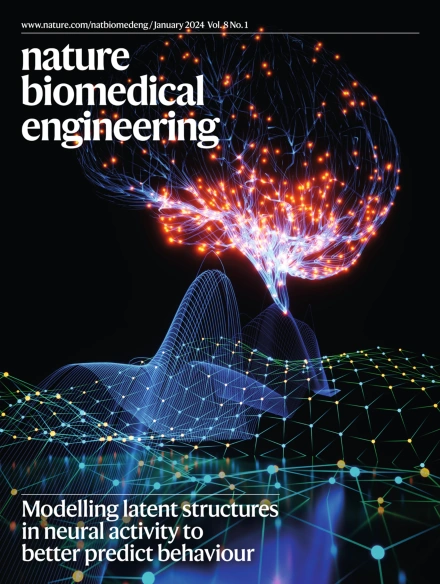A stealthy neural recorder for the study of behaviour in primates
IF 26.8
1区 医学
Q1 ENGINEERING, BIOMEDICAL
引用次数: 0
Abstract
By monitoring brain neural signals, neural recorders allow for the study of neurological mechanisms underlying specific behavioural and cognitive states. However, the large brain volumes of non-human primates and their extensive range of uncontrolled movements and inherent wildness make it difficult to carry out covert and long-term recording and analysis of deep-brain neural signals. Here we report the development and performance of a stealthy neural recorder for the study of naturalistic behaviours in non-human primates. The neural recorder includes a fully implantable wireless and battery-free module for the recording of local field potentials and accelerometry data in real time, a flexible 32-electrode neural probe with a resorbable insertion shuttle, and a repeater coil-based wireless-power-transfer system operating at the body scale. We used the device to record neurobehavioural data for over 1 month in a freely moving monkey and leveraged the recorded data to train an artificial intelligence model for the classification of the animals’ eating behaviours. A stealthy neural recorder allows for the study of the behaviour of non-human primates in naturalistic settings.


用于灵长类动物行为研究的隐形神经记录器
通过监测脑神经信号,神经记录器可以研究特定行为和认知状态的神经机制。然而,非人灵长类动物的脑容量大,不受控制的运动范围广,且具有与生俱来的野性,因此很难对深层脑神经信号进行隐蔽、长期的记录和分析。在此,我们报告了用于研究非人灵长类动物自然行为的隐蔽式神经记录器的开发和性能。该神经记录器包括一个用于实时记录局部场电位和加速度数据的完全可植入式无线无电池模块、一个带有可吸收插入梭的灵活的 32 个电极神经探针和一个基于中继线圈的体表无线功率传输系统。我们使用该装置记录了一只自由活动的猴子一个多月的神经行为数据,并利用记录的数据训练了一个人工智能模型,用于对动物的进食行为进行分类。
本文章由计算机程序翻译,如有差异,请以英文原文为准。
求助全文
约1分钟内获得全文
求助全文
来源期刊

Nature Biomedical Engineering
Medicine-Medicine (miscellaneous)
CiteScore
45.30
自引率
1.10%
发文量
138
期刊介绍:
Nature Biomedical Engineering is an online-only monthly journal that was launched in January 2017. It aims to publish original research, reviews, and commentary focusing on applied biomedicine and health technology. The journal targets a diverse audience, including life scientists who are involved in developing experimental or computational systems and methods to enhance our understanding of human physiology. It also covers biomedical researchers and engineers who are engaged in designing or optimizing therapies, assays, devices, or procedures for diagnosing or treating diseases. Additionally, clinicians, who make use of research outputs to evaluate patient health or administer therapy in various clinical settings and healthcare contexts, are also part of the target audience.
 求助内容:
求助内容: 应助结果提醒方式:
应助结果提醒方式:


